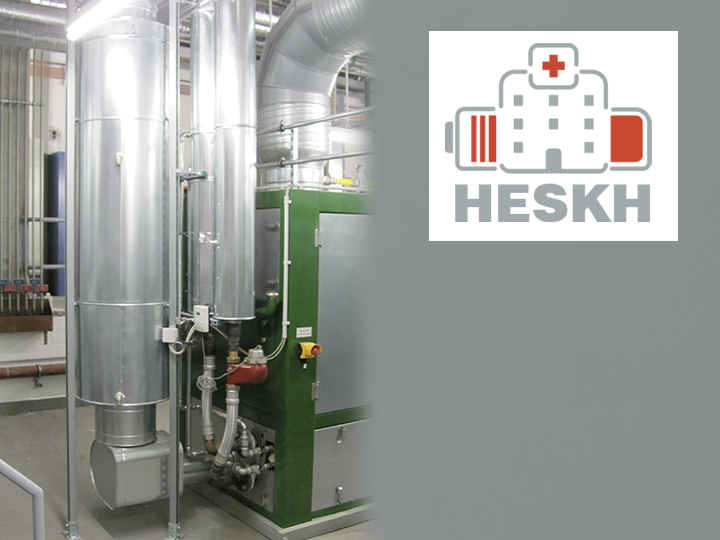Load shifting
Replace fossil-fuel power plants, save costs and contribute to the energy transition through the flexible operation of utility plants
Whether combined heat and power (CHP) or chillers – in many German hospitals are plants which, due to their size, are excellently suited to promote the integration of renewable energies as well as to take advantage of short-term fluctuations in the price of electricity. Fraunhofer UMSICHT, Stadtwerke Bochum GmbH and Evangelisches Krankenhaus Hattingen have investigated the achievable potential of load shifting in the project "Hybrid Energy Storage Hospital (HESKH)". One of their results: If all CHP plants currently installed in hospitals are operated flexibly and the operation is optimized according to the market prices for electricity, there is – roughly estimated ¬– a load shifting potential of about 300 MW for positive and 200 MW for negative flexibility.

The project kicked off in October 2018. "We started with the objective of determining the potential for load shifting in hospitals and the resulting economic benefits for hospitals," explains Dr. Anne Hagemeier from Fraunhofer UMSICHT. "Another focus was on forecasting the heat demand, which plays an important role in the predictive control of utility plants."
Understanding energy consumption in hospitals and identifying potential savings
Over a period of more than a year, the heating and cooling loads in the Evangelisches Krankenhaus Hattingen were measured in an extensive monitoring process and supplemented by short-term measurements of individual electricity consumers and departments. The results were incorporated into various models created in the project and made it possible to understand the composition of energy consumption and uncover potential savings. At the same time, a simulation of energy consumption and supply made it possible to identify opportunities for energy savings and cost reductions.
"It was shown that – if the nominal load of the hospital's combined heat and power plant (CHP) exceeds the base load and thermal storage units are available – flexibility can be provided and economic advantages can be achieved. Even if a constant electricity price is used," says UMSICHT scientist Sebastian Berg. "If we assume a dynamic electricity tariff based on the exchange electricity price, the electricity costs can be additionally reduced by up to 15 percent. Electricity generation with the CHP unit then preferably takes place at times when electricity prices are high."
Putting predictive control into practice with the help of forecasting models
In order to implement predictive control in practice, it is necessary to forecast framework conditions. These include the energy demands (electricity, heat, etc.), the prices for their purchase and sale, and non-controllable self-generation (photovoltaics, solar thermal). "In order to achieve high forecast accuracy, we created different forecast models based on artificial neural networks, among other things, and then tested them simulatively," UMSICHT scientist Malte Stienecker describes the procedure. "In the process, we were able to determine that although the forecast deviations could be partially compensated for by the hospital's thermal storage system, regular adjustments to the originally plant schedules, which were based on forecast data, were necessary in order to cover the heat demand that actually occurred."
Additionally occurring operating costs depend on both the deviations magnitude as well as their timing. For example, increased schedule adjustments were necessary above all in the winter months. However, at this time – due to the higher heat demand – the peak load boilers are running, which can adjust their heat generation at short notice and without affecting the electricity side. The situation is different in the summer months: Then the hospital exclusively uses the CHP for heat supply, such that schedule adjustments have a greater impact because, for example, less electricity may be produced.
Load shifting potential of hospitals in Germany
Incidentally, the project results are transferable to other hospitals as well as other building types with similar facilities or similar energy generation –like hotels, swimming pools or commercial operations. Sebastian Berg: "We conducted an analysis of the hospital landscape in Germany and extrapolated the determined load shifting potential for the hospital in Hattingen. The result: If all CHP plants currently installed in hospitals are operated flexibly, there is a load shifting potential of about 300 MW for positive and 200 MW for negative flexibility – if the operation of the plants is optimized according to the market prices for electricity. "In other words, through improved control, hospitals can contribute to the energy transition and save costs at the same time.
Last modified:
 Fraunhofer Institute for Environmental, Safety and Energy Technology UMSICHT
Fraunhofer Institute for Environmental, Safety and Energy Technology UMSICHT